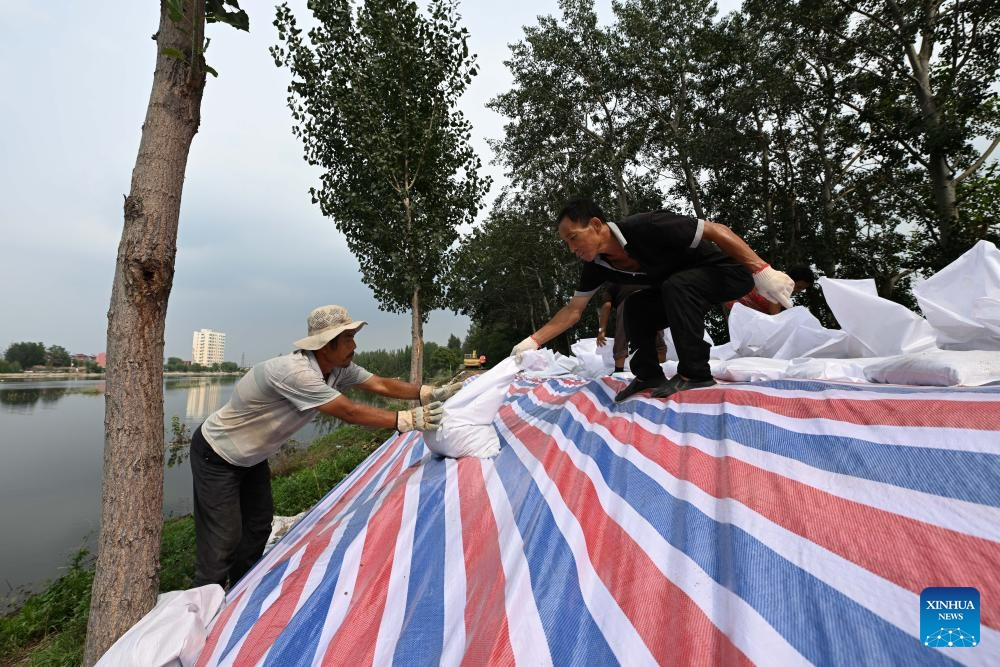Disaster relief underway after flooding ravages northern China

Members of a post-disaster reconstruction working group recently walked into the flooded Xinle village, located in Wuchang city of Northeast China's Heilongjiang Province, to investigate and identify flood-hit houses. According to estimates, review of all the homes in 24 townships will complete in three to four days.
In the aftermath of Typhoon Doksuri, Heilongjiang and multiple other regions in China, including Beijing and North China's Hebei Province, have ramped up efforts to restore order for people living in inundated areas.
In Guyu village, Wuchang city, more than 2,000 mu (133 hectares) of corn has been soaked in water. The local emergency department has transferred large-scale pumping facilities to carry out 24-hour drainage of farmland water. Wuchang has mobilized six post-disaster technical guidance groups to provide technical guidance for villagers in 24 towns and villages for draining field water and spraying pesticides to prevent and control pests and diseases.
At Sunday midnight, a train carrying 690 tons of Wuchang rice left the local train station. This was the first train of food supplies transported from Wuchang station after the resumption of the railway, which was cut off by flooding.
People wearing protective gear for disinfection in Shangzhi, one of the seriously stricken cities in Heilongjiang, have completed three rounds of disinfection across more than 320,000 square meters of flood-affected areas.
In response to the flooding of farmland, Hebei Province organized experts and technicians to head to the front lines of the disaster resistance to guide post-disaster agricultural production. At the same time, the province promptly redirected 1.06 million kilograms of seeds of short-growth crops such as cabbage and spinach to prepare for replanting to minimize farmers' losses.
In Zhuozhou, Hebei, four shopping malls and 29 supermarket chains have resumed operation and schools are also stepping up efforts to clean up sludge and disinfect areas to ensure the timely return of students to campus in September. Hebei officials had said earlier that it plans to complete the reconstruction in two years and will take efforts to ensure affected residents are able to return to their homes prior to the approach of winter.
In Beijing, the lives of local people have gradually resumed. Most recently, six A-level scenic spots in the Fangshan district have reopened. The Fangshan district has labeled regions into three colors based on the severity of flood impact - red, yellow and green - serving as a more efficient method to solve disaster relief work. Officials from Beijing said they have mapped out a plan to improve the city's disaster relief capabilities and the development of flooded regions over the next three years.
Not only have local departments in flood-stricken regions moved quickly to deal with disaster relief, the Ministry of Agriculture and Rural Affairs urged agricultural departments at all levels to make efforts to alleviate disaster and promote vegetable production.
Meanwhile, to deal with future emergent heavy rainfall and floods and improve the adaptability of urban infrastructure to withstand extreme weather, observers have suggested that the impact infrastructure in some high-risk areas may face from extreme rainstorms brought by climate change be re-evaluated to determine whether the existing level of defense needs to be upgraded, as well as to improve the vigilance and preparedness of local departments and strengthen resilience in the face of a changing climate.
Some water control experts said this round of heavy rainfall reminded some places to make up for the shortcomings of local flood control projects. They pointed out some northern cities in recent years have relaxed their vigilance and constructed flood storage areas in a disorderly manner, such as when building houses, locals may take soil from earth dams, which weakens the flood control capacity of levees.
Sun Shao, a senior researcher at Chinese Academy of Meteorological Sciences, told the Global Times that challenges encountered by cities in northern China due to deficient drainage systems, limited river networks, and inadequate urban green space planning, makes them highly vulnerable to flooding during unexpected heavy rainfall.
Cheng Xiaotao, a deputy chief engineer from the China Institute of Water Resources and Hydropower Research (IWHR), told the Global Times that besides flood control projects, effective communication about the severity of extreme weather among meteorological, hydrological and water conservancy departments is crucial. For instance, emergency command departments can compile data about the specific precipitation and flow rate of rivers and inform the public in detail.
As heavy rainfall events intensify, there is a higher probability of sudden flash floods, mudslides, and other disasters, Sun said. He explained that reviewing historical patterns, during the 1950s to 1970s, the main rain belt was concentrated in northern China, which later shifted to southern China in the 1980s and 1990s. Since the beginning of the 21st century, the main rain belt has gradually moved northward again.